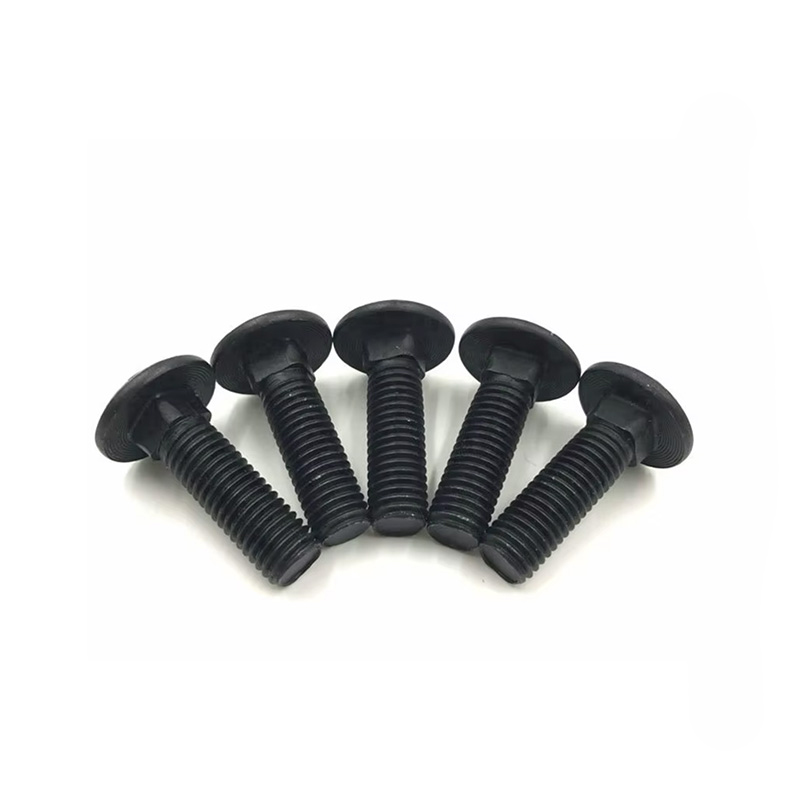Carbon steel mushroom bolts are widely used in railway systems, timber connections, heavy machinery, and structural applications. Their mushroom-shaped head design provides a secure fastening solution, especially in situations where the bolt needs to resist pull-through or requires a large bearing surface. The performance and longevity of these bolts, however, depend heavily on the manufacturing processes used. Forging, machining, and hot-dip galvanizing each play a significant role in shaping the quality, strength, and durability of carbon steel mushroom bolts.
Content
1. Forging
Process Overview
Forging involves heating the carbon steel and shaping it under high pressure, typically through hammering or pressing. This process aligns the grain structure of the metal along the contours of the mushroom bolt.
Impact on Quality
- Strength and Toughness: Forging improves tensile strength and fatigue resistance by refining the grain structure and eliminating internal voids.
- Durability: The mushroom head formed through forging resists deformation under heavy loads, making the bolts reliable in structural and railway applications.
- Consistency: Forged bolts have uniform properties throughout the part, reducing the likelihood of weak points.
Applications
Forged carbon steel mushroom bolts are preferred in demanding industries such as railway track fastening and heavy timber construction, where mechanical strength is critical.
2. Machining
Process Overview
Machining involves shaping the bolt by cutting material away from a steel rod or blank using lathes, milling machines, or CNC equipment.
Impact on Quality
- Precision: Machined mushroom bolts achieve tighter dimensional tolerances, which is important for specialized assemblies requiring exact fits.
- Surface Finish: Machining produces a smoother finish, reducing stress concentrations that could lead to fatigue failure.
- Flexibility: This method allows manufacturers to produce customized bolt sizes or designs in smaller batches.
Limitations
- Machined bolts are typically less strong than forged bolts because machining cuts through the natural grain flow of the steel.
- Production costs are higher for large volumes compared with forging.
Applications
Machining is ideal for custom orders, prototypes, or applications where dimensional accuracy is more critical than maximum load-bearing strength.

3. Hot-Dip Galvanizing
Process Overview
Hot-dip galvanizing is a surface treatment where the fully formed carbon steel mushroom bolt is immersed in molten zinc, creating a thick, protective coating.
Impact on Quality
- Corrosion Resistance: The zinc coating protects the steel from rust by serving as a sacrificial layer, extending the service life of the bolt in outdoor or harsh environments.
- Durability in Service: Galvanized bolts perform well in railway, marine, and construction applications exposed to moisture and weathering.
- Layer Thickness: A uniform coating ensures consistent performance, but overly thick layers may affect thread tolerance and fit.
Considerations
- Hydrogen embrittlement risk is lower than with electroplating, making hot-dip galvanizing suitable for high-strength bolts.
- The process may slightly reduce the sharpness of threads, requiring adjustments during manufacturing.
Applications
Hot-dip galvanized mushroom bolts are essential in outdoor construction, bridge building, and railway fastening systems, where corrosion resistance is a top priority.
4. Combined Influence on Quality
The overall quality of carbon steel mushroom bolts depends on a combination of these processes:
- Forging ensures strength and structural reliability.
- Machining provides precision and customization.
- Hot-dip galvanizing enhances corrosion resistance and long-term performance.
By carefully selecting and combining processes, manufacturers can produce bolts that meet the specific demands of different industries, balancing mechanical performance, durability, and cost.
Conclusion
The manufacturing process directly impacts the performance characteristics of carbon steel mushroom bolts. Forging delivers superior strength and toughness, machining offers precision and customization, and hot-dip galvanizing provides essential corrosion resistance. For critical applications such as railway infrastructure or outdoor structural projects, combining forging with galvanizing often produces the most durable and reliable bolts. Meanwhile, machining remains the method of choice for custom applications requiring precise dimensions.
Ultimately, understanding how these processes influence bolt quality allows engineers, manufacturers, and end-users to select the right type of carbon steel mushroom bolt for each specific environment and performance requirement.

 English
English 中文简体
中文简体 Español
Español русский
русский عربى
عربى








